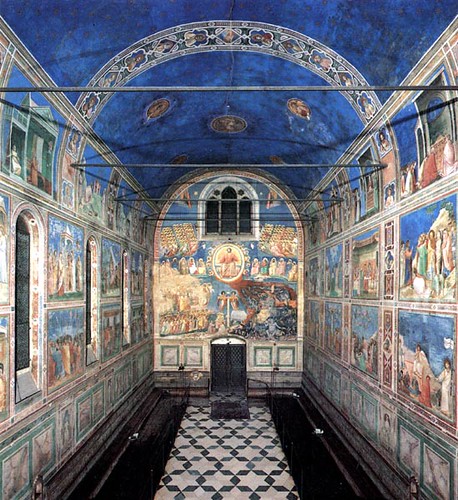
Chapel interior, barrel vaulted roof. (Source)
I went to Padua on my day off a couple of weeks ago, with the principal intention of going to the Scrovegni Chapel, and seeing the first anatomical theatre in the world, at the University of Padua. I'd hoped to come across some fabulous shoes while I was there, at less than "Venetian prices", but alas, that part of the plan didn't work out.
Understandably, you weren't permitted to take photographs in either of these places. This is certainly justified in the case of the Scrovegni Chapel, as besides the conservatory concerns, trying to convey the awe that Giotto's frescoes inspire in one, once in the chapel, this would be fruitless. My opinion on this also applies to taking photographs of paintings, a pathetic reproduction of a painting you've seen, taken without skill or the proper lighting conditions or permission, to be uploaded without thought to a facebook album, is really lame, and incredibly frustrating for galleries, I imagine. The artist would be spinning in their grave I reckon.

Interior. (Source)

Detail from the Last Judgement fresco: Enrico Scrovegni himself is included in one of the frescoes, depicted as presenting the Arena Chapel as an offering, dressed in violet, the colour of sin. (Source).

Giotto, the Crucifixion. (Source)
Scrovegni Chapel
The Scrovegni Chapel, (or Cappella degli Scrovegni, also known as the Arena Chapel) contains a fresco cycle by Giotto, completed about 1305, that is one of the most important masterpieces of Western art. For those of you who studied art history at a secondary school and perhaps university level, will most likely recognise Giotto's work.
The chapel was commissioned by Enrico Scrovegni, whose family fortune was made through banking, the question is whether or not Enrico himself was involved in usurious practices and if the chapel was intended as restitution for his own sins. It is suggested that Giotto's frescoes in the chapel reflect these concerns with usury and penitence. Apart from Giotto's paintings, the chapel is unornamented and features a barrel vault roof. Giotto's Last Judgment covers the entire wall above the chapel's entrance and includes the aforementioned devotional portrait of Enrico.
Truthfully, I wasn't expecting the chapel to be so large. I had only previously seen the interior in textbooks. The brilliant cobalt blue of the ceiling is one of the most striking things about the interior. The frescos themselves are so rich in detail, that at times it felt overwhelming, so you really had to scan everything and perhaps focus your attention on a few selected ones.
I felt so privleged, to be standing there, to be looking at frescoes that were over 700 years old. The conservation of the chapel began at the end of the nineteenth century, but only entered into its most intensive phase within the past 20 years. You are only permitted within the chapel for 15 minutes, as the climate within the chapel is controlled, to prevent further deterioration of the sensitive wall surface.
All in all, it is an absolute must on any trip to Padua. My ticket, purchased online in advance was €3.50 each way. So even if you are only in Venice for a short period of time, you probably could pop over for the afternoon. Tickets must for the chapel must be purchased in advance, and you are expected to turn up 10-15 minutes before you are admitted entry to the chapel.
Anatomical Theatre, University of Padova
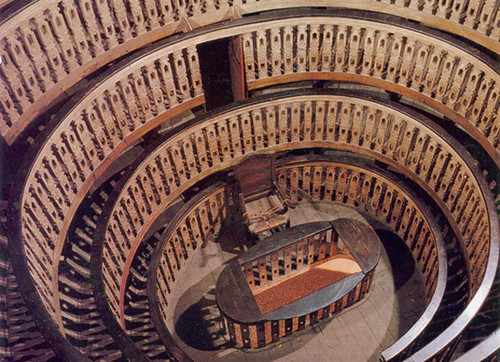
Anatomical Theatre, University of Padova. Where anatomy students (capacity 350 people) stood and learned from direct observation of the opened body on the table beneath the centre of the gallery. (Source)
As an undergrad I undertook a module 'Art and Death', taught by the brilliant Dr. Philip Cottrell at UCD, ever since then I've been fascinated by anatomical drawings and the macarbe and the gruesome in art. We learnt about the gifted anatomist and physician Andreas Vesalius, author of one of the most influential books on human anatomy, De humani corporis fabrica (1543) (On the Structure of the Human Body) and his role as chair of Surgery and Anatomy at Padua (1537-43).
The University of Padua was founded in 1222, making it one of the oldest universities in the world, and the second oldest in Italy, after Bologna. The Anatomical Theatre at Padua (in Palazzo Bo) is one of the first of its kind in the world (1594). It is arranged in an amphitheatrical shape, where the dissection of the body would take place in the centre. The dissection of human cadavers was illegal at this time, and I suppose you could say that there was an theatrical element in the performance of dissection by the anatomist.
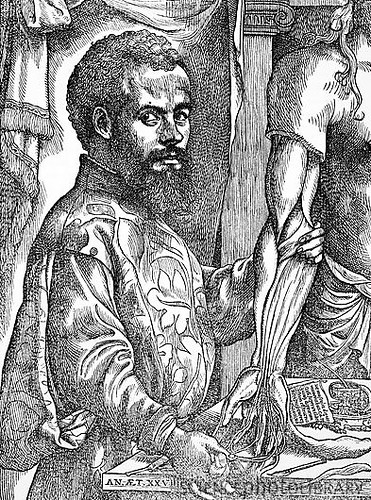
Andreas Vesalius
The city of Padua itself is a mixture of the old and new, it felt strange being on land again and dodging cars while dashing across the street. We went for a ramble around, and discovered we had gone on a total roundabout way around the city (we didn't have a map) when actually the distance between the Scrovegni Chapel and Palazzo Bo is no more than a 5-10 minute walk. Beware of asking an Italian for directions because the answer is usually "Straight ahead!".
Shopping
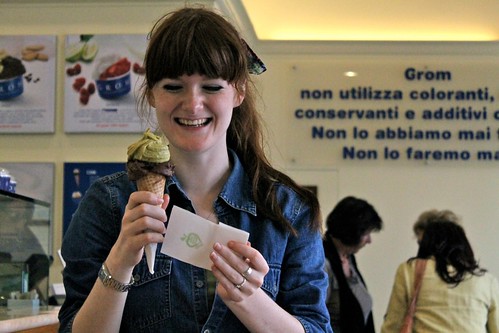
Looking very excited at the prospect of eating chocolate and pistachio ice-cream from GROM
There is a big square where they hold a large market on Saturdays. I stopped off to get my gelato fix at GROM, where they serve artisan, organic gelato. I opted for a favourite mix of mine, pistachio and dark chocolate. Compared to the pistachio flavours I had, it tasted almost savoury, when combined with the dark chocolate it did make for an interesting flavour. It was €3 for a cone with 2 scoops, which is a little more than I've paid so far, but it was organic (biologica). Many of their flavours are gluten free and therefore coeliac friendly.
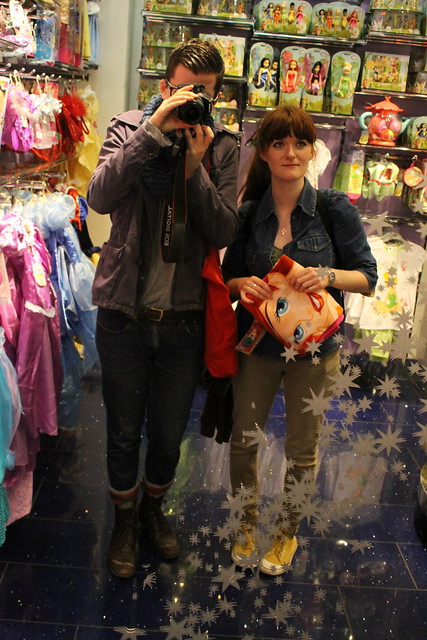
Finn & I at the Disney store, and I did buy that towel (on sale)
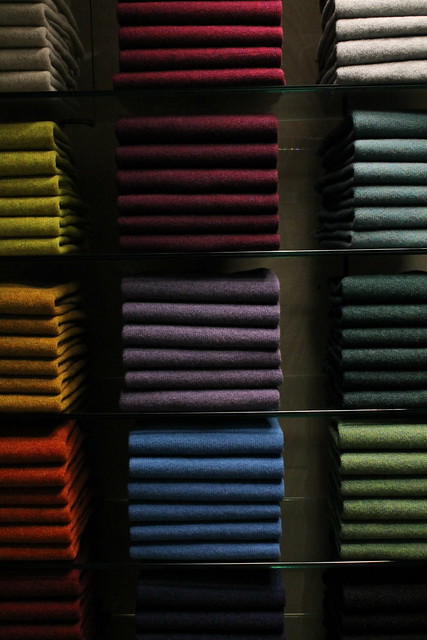

Thinking ahead for the weather back home obviously
We stopped into a few shops, hoping to find some lovely Italian shoes, although it wasn't my principal reason for coming there, i was disappointed by the shopping there. They had the generic high street shops such as H&M and Zara, as well as some boutiques, and the department store Coin, but I was after something more genuinely Italian. Suddenly I found myself buying a pair of orange flared cords in Benetton, but more on that another time!

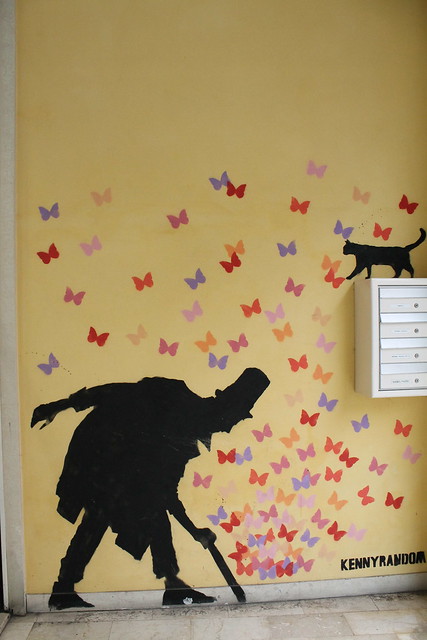
It is a lovely city to go for a walk around, particularly the older part, as no cars are permitted. There are lovely churches, and plenty of shady arches to walk under. The train station is a little more exposed, and I've been told that its dangerous to be alone there at night. Overall, my trip to Padua was a success. Next time, if there is one, I'd like to see the Basilica of St. Anthony, his tongue and jaw are on display there, how gruesome!
Read more:
Giotto and the Arena Chapel
Official Website of the Scrovegni Chapel
(All photos in this post were taken by the charming Finn MacLeod)

so glad you bought that towel :p
ReplyDeleteSo jealous :D You look like your having such an amazing time xx
ReplyDeleteTHOSE SWEATERS
ReplyDelete